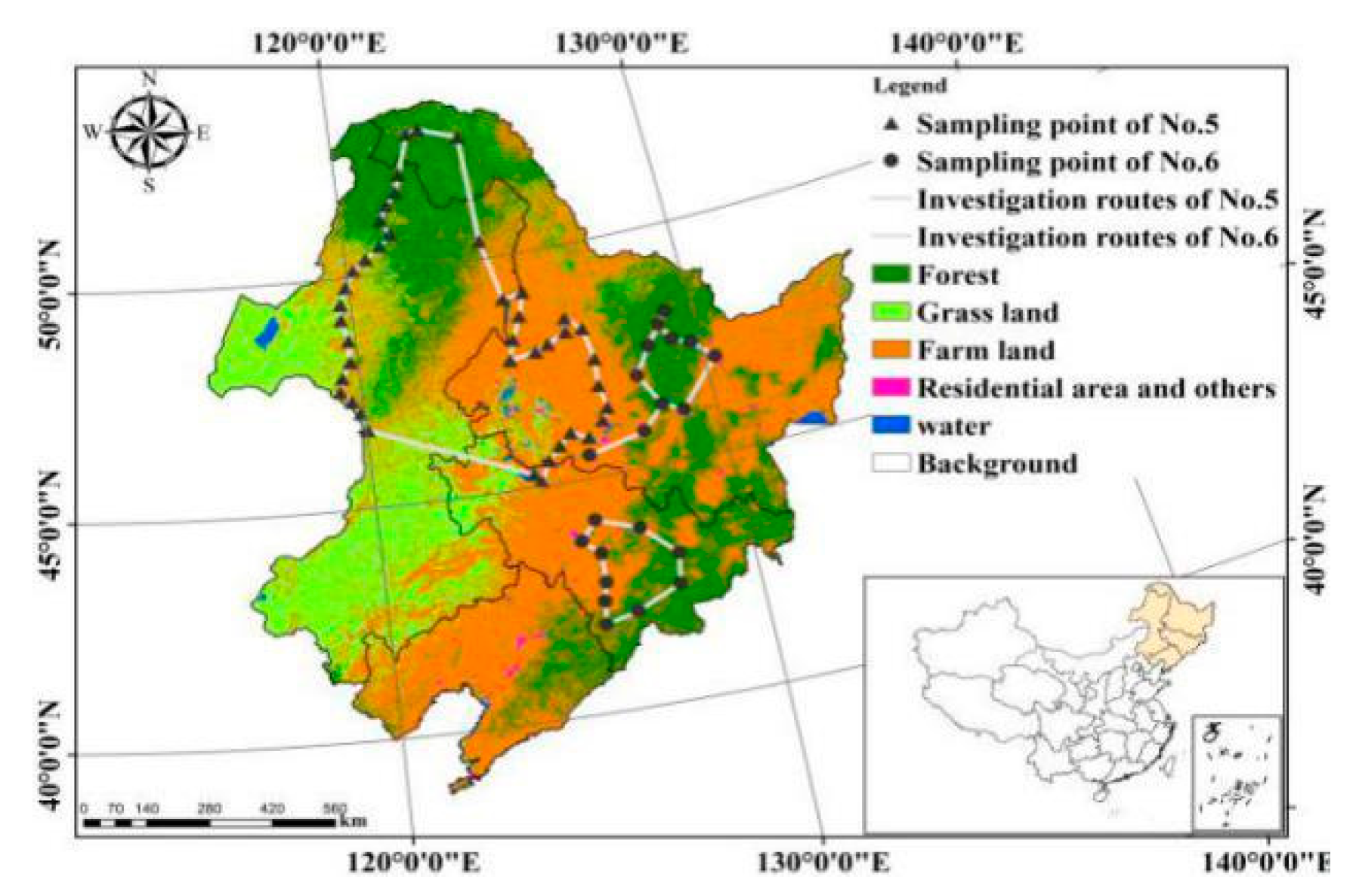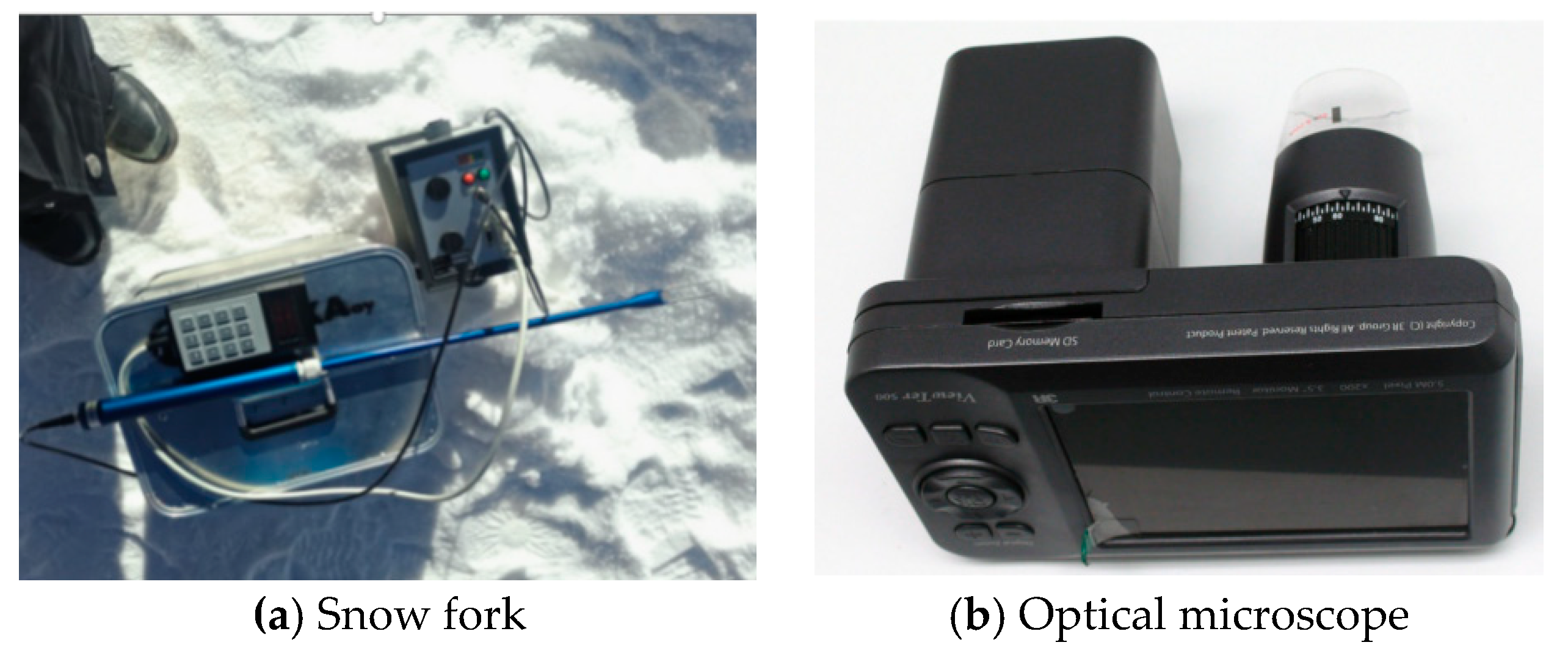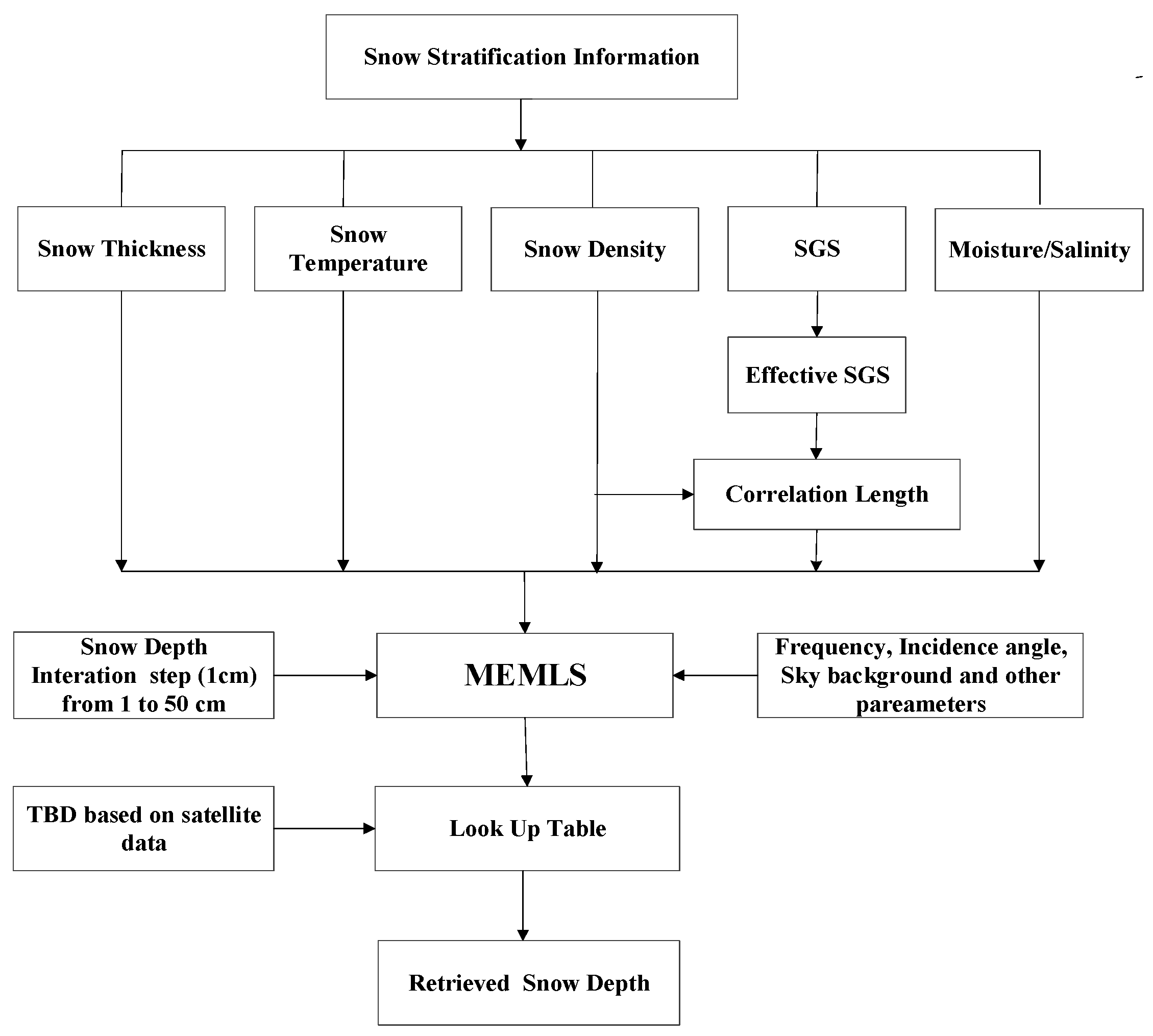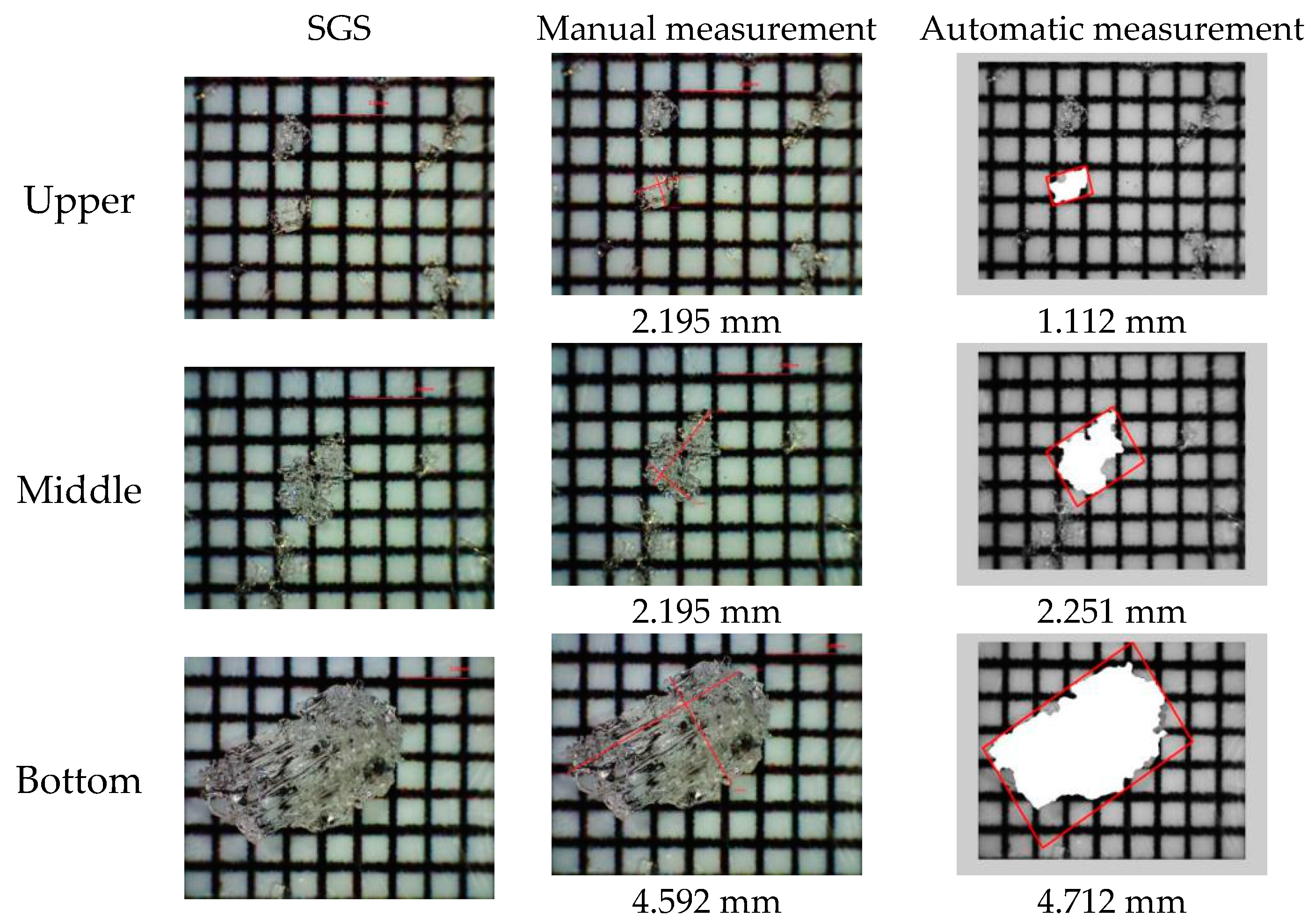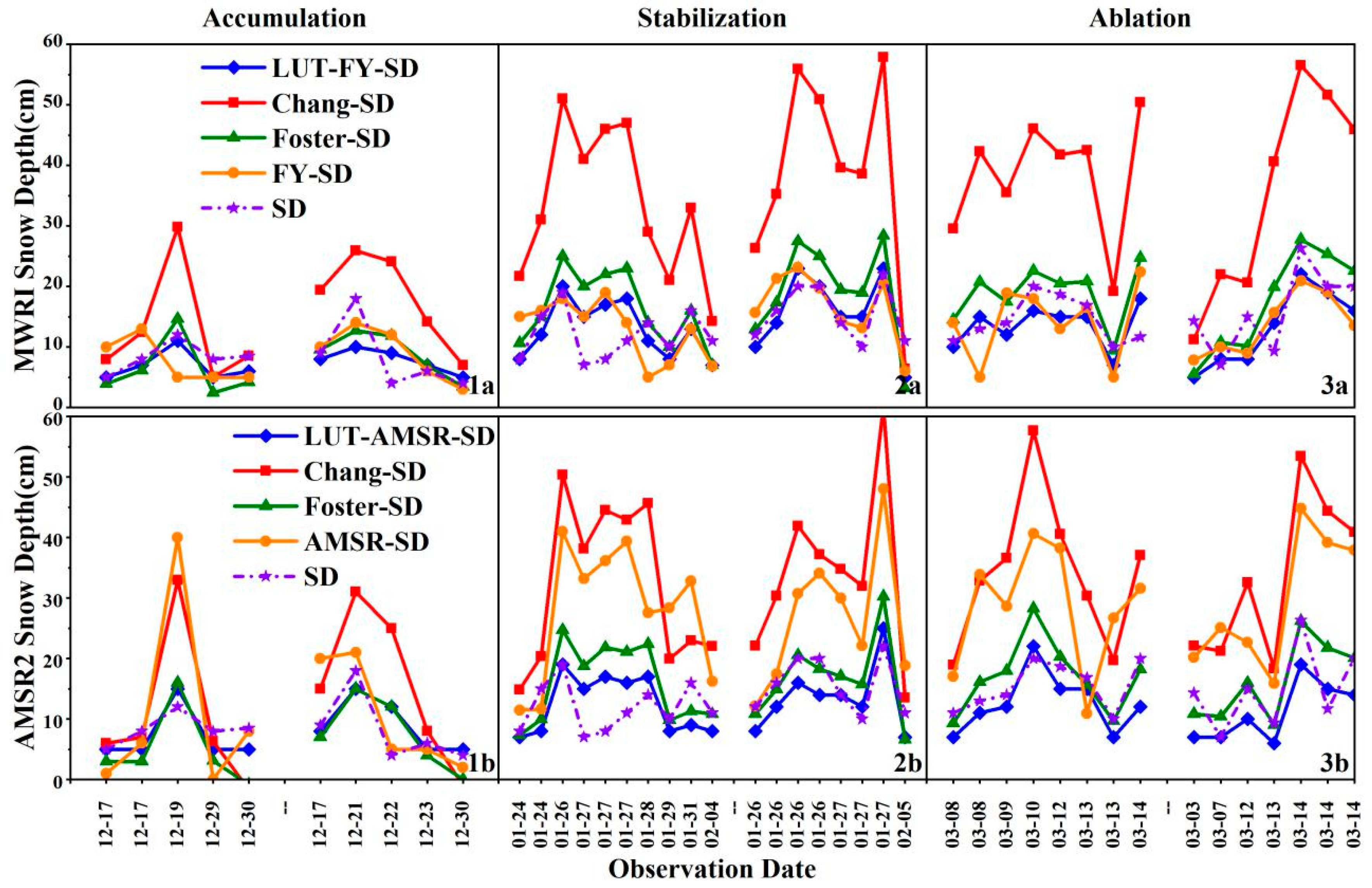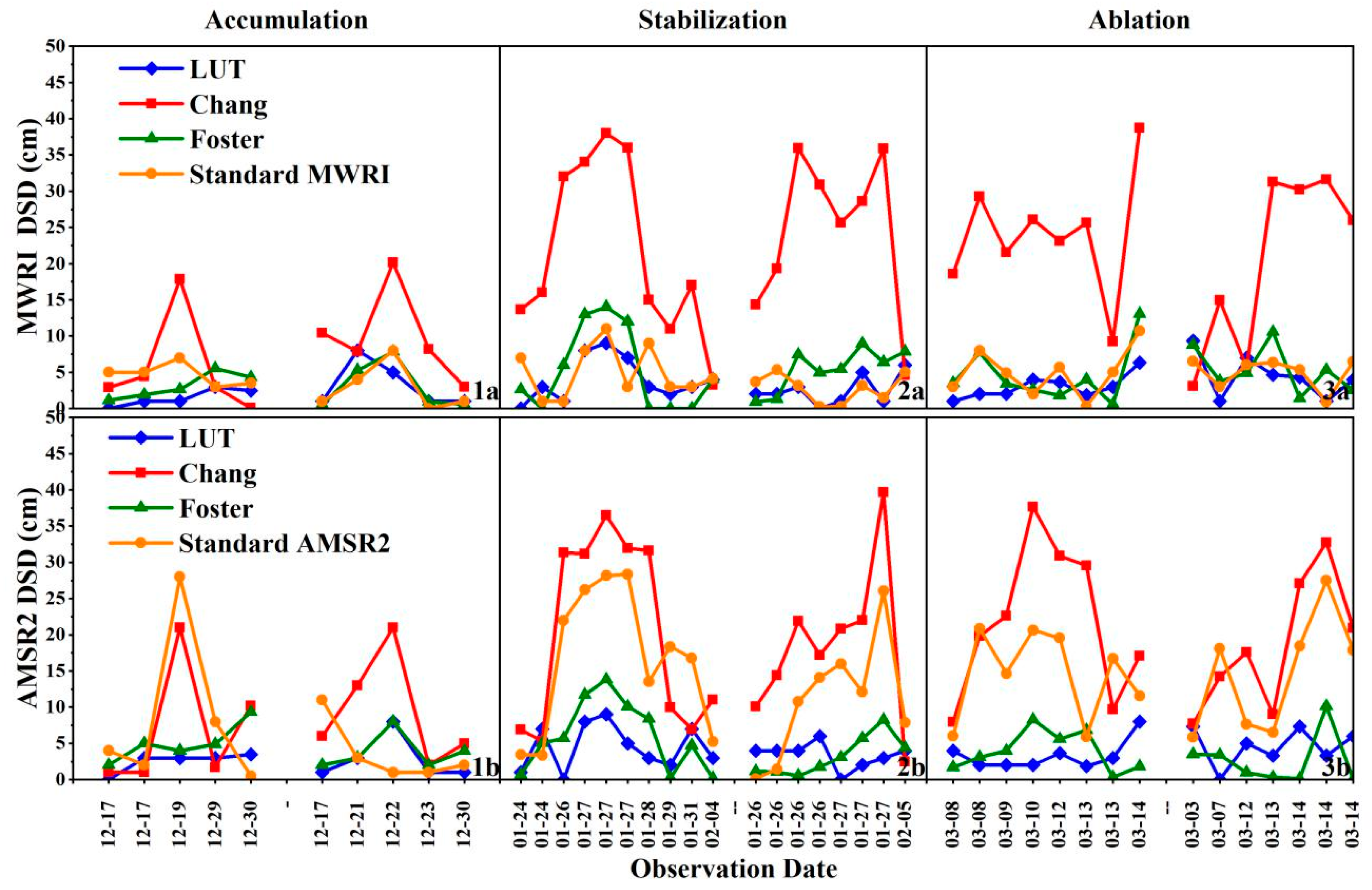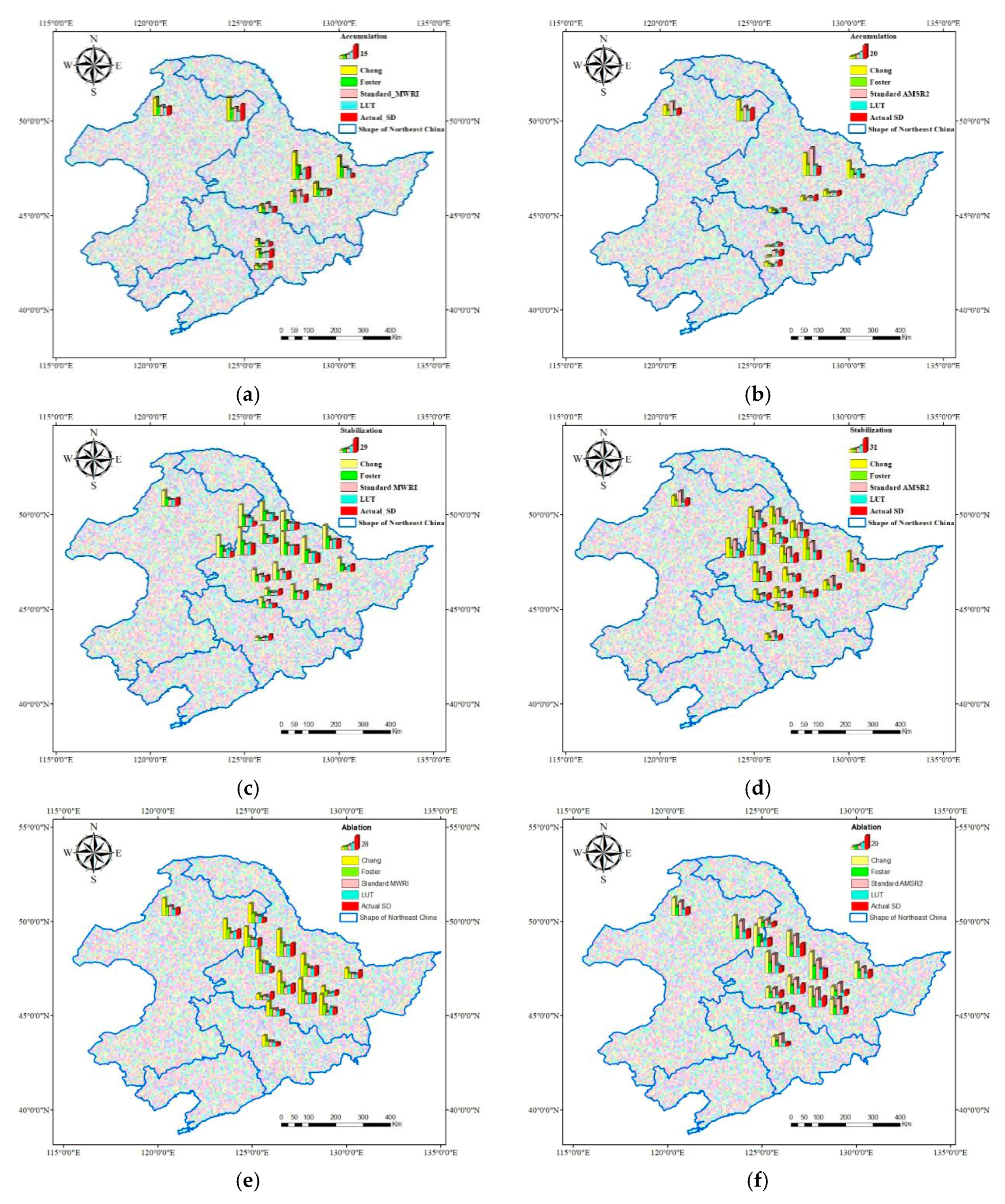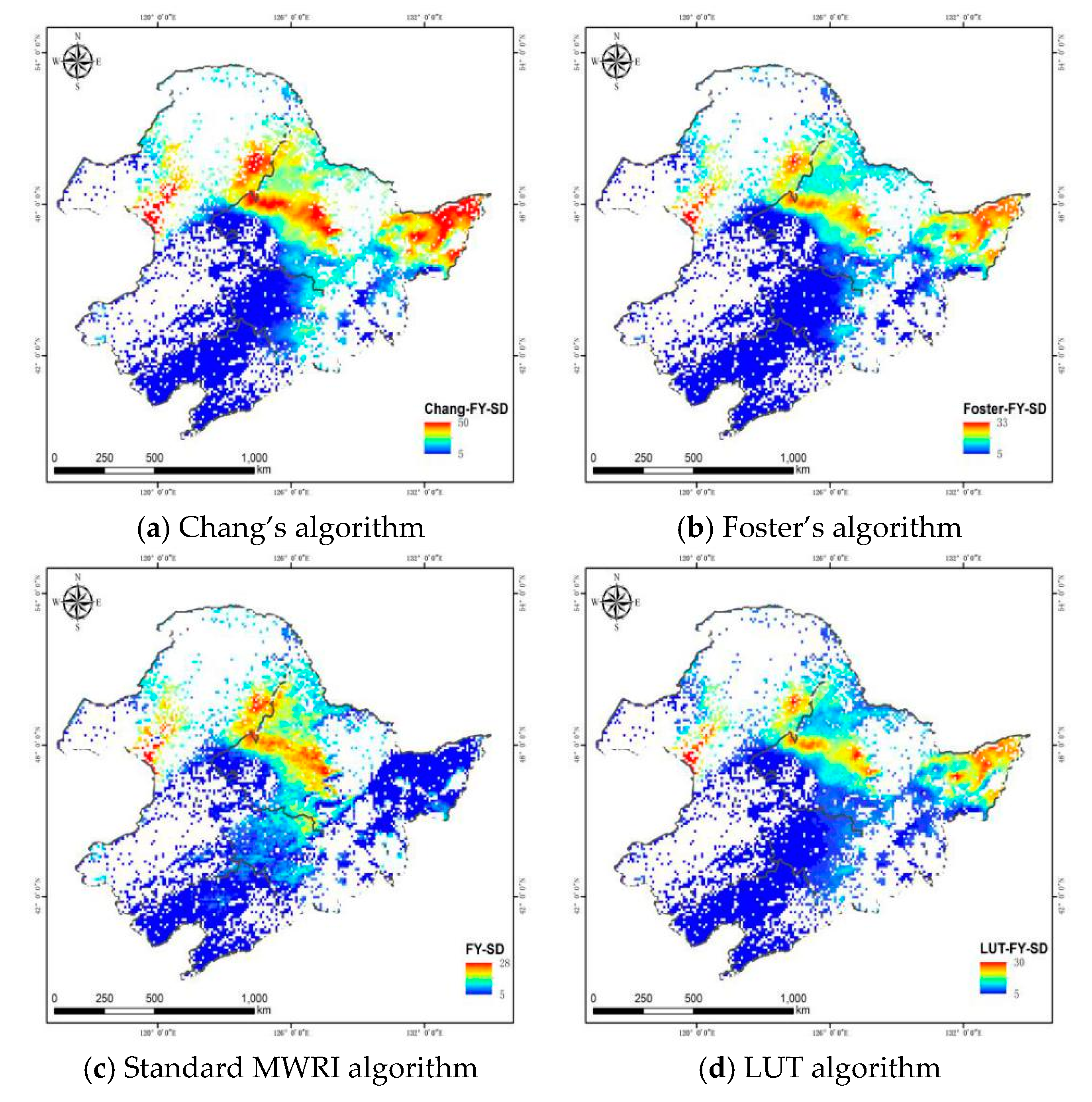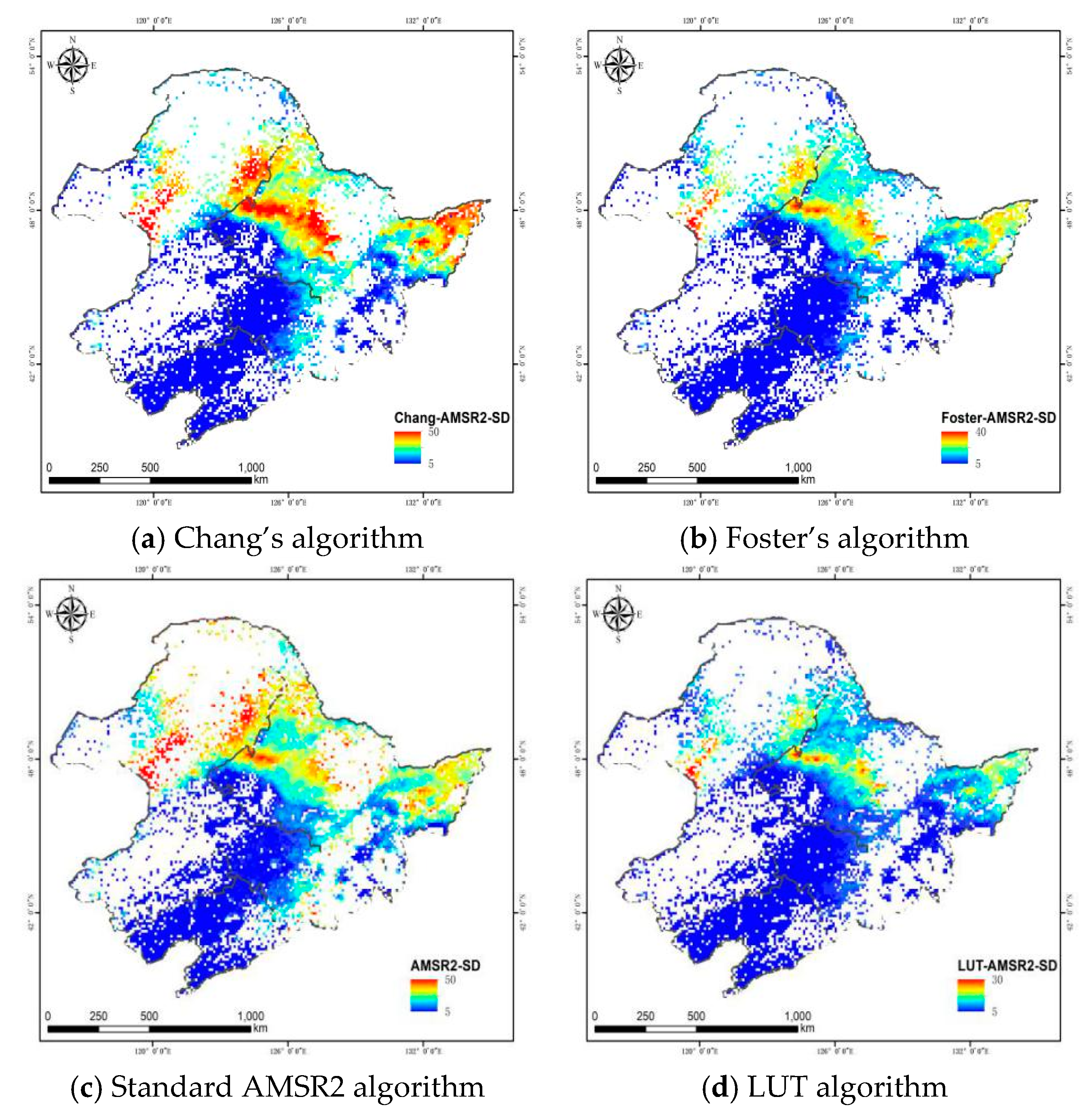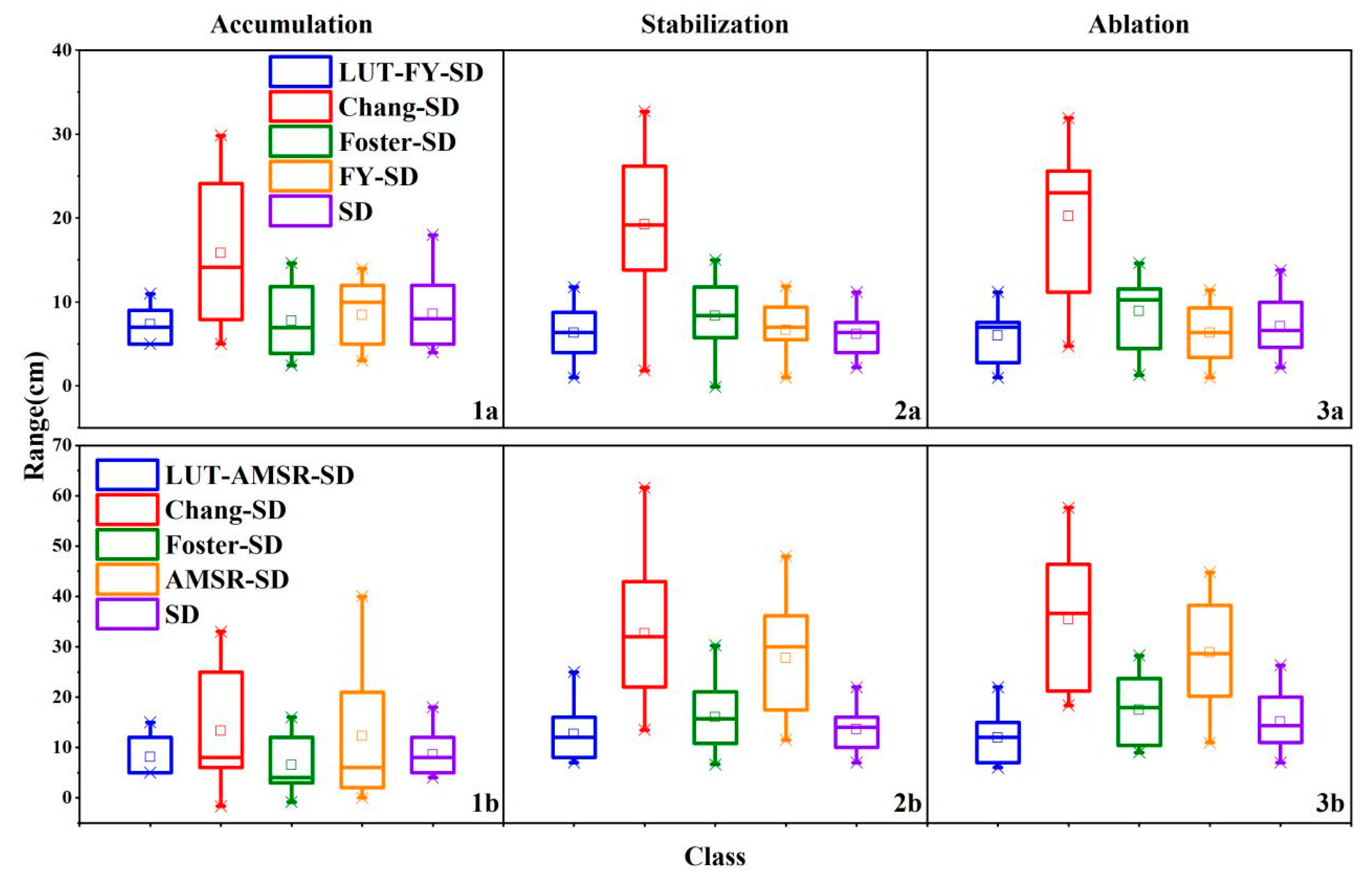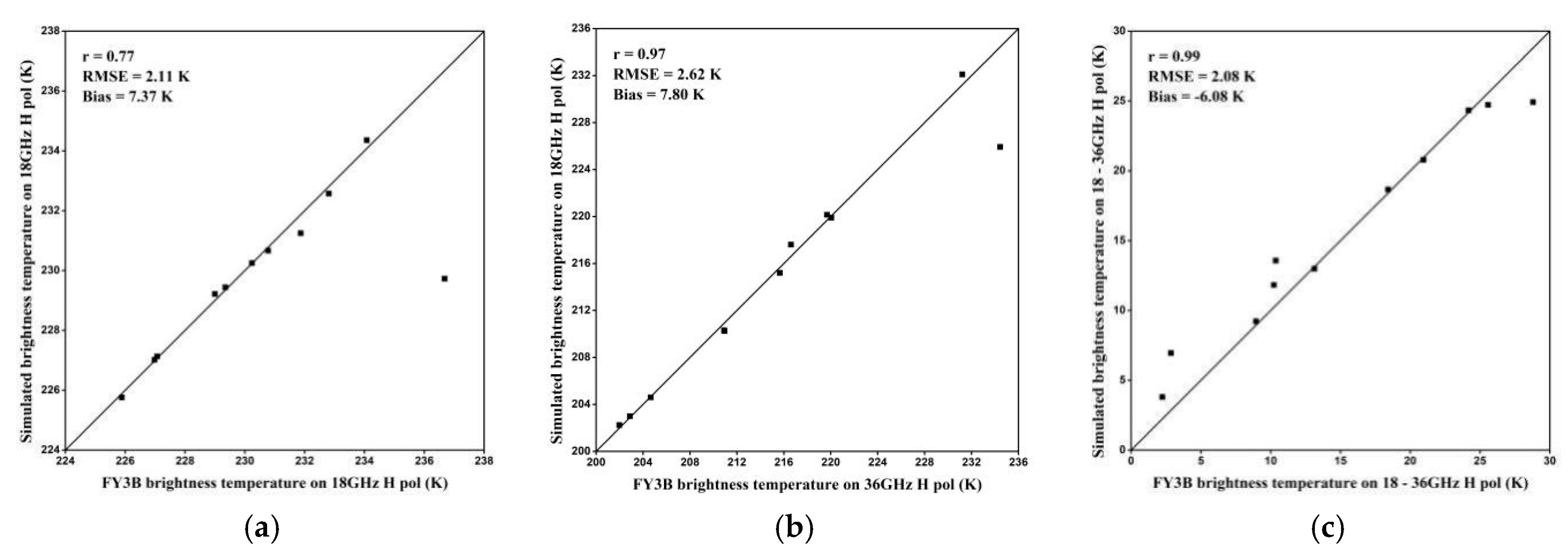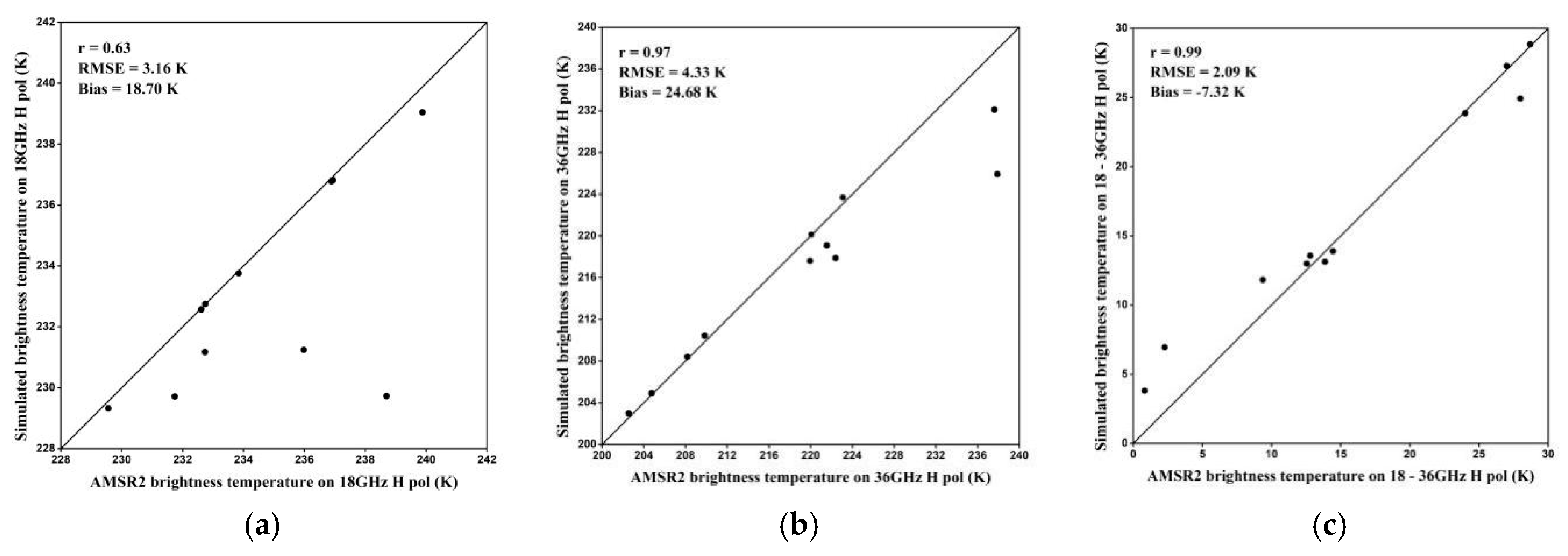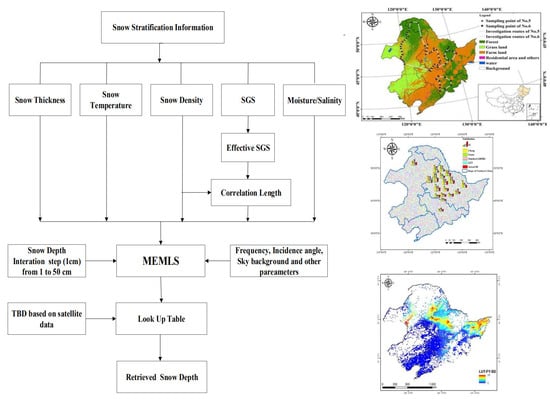Accurate simulation of the TB of snowpacks using MEMLS requires prior information of snow parameters. According to the snow measurement results from the three snow investigations, each parameter can be empirically determined using the following strategies.
3.3.1. Snow Stratification
During the snowy season, new snowfalls continue to cover previous snowfalls, resulting in a gradual stratification of snow. Based on the field measurements in farmland, it was found that snow cover could be divided into three-layered snowpacks (
Figure 4). SD and snow stratification mostly satisfied the following relationships: when SD was less than 7 cm, snow cover was not stratified and defined as one layer; when SD was 8–15 cm, snow cover was characterized as two layers, and the thickness of upper and bottom layer were assumed to be equal; when the actual SD exceeded 15 cm, the snow cover was divided into three layers. For the three-layer snowpacks, the same thickness was assumed for the upper and bottom snow layers. In the snow field measurements, it was found that the SD in Northeast China was never more than 50 cm, so an SD over 50 cm was not considered in this study.
The snow cover depth (SD) can be expressed as follows:
where LayerNum represents the number of snow layers and the thickness represents the thickness of each snow layer. Although in situ measurements of SD were not directly used in MEMLS, they are an important basis for determining the stratification of the snowpack. Based on the snow stratification information, the snow density, SGS, temperature, and other parameters of each layer were further measured. The measured SD was also recorded as the actual SD.
3.3.2. Snow Temperature
Snow temperature influences the retrieval of the SD to some extent. Generally, snow cover has a thermal insulation effect on the ground. The deeper the snow cover, the more obvious the thermal insulation effect [
32]. According to the actual measurement results, the snow temperature is generally higher than the air temperature. For simplicity, in this study, snow temperatures (T
snow) were determined by the following empirical equation:
where T
air represents air temperature in °C, SD represents snow depth in cm, slope represents the rate of change of snow temperature with SD which can be determined on the basis of the snow temperature and air temperature obtained from the measurement data. Thus, regression slopes in the three periods of snow accumulation, stabilization, and ablation were made.
As shown in
Figure 5a,b, the snow temperature at the air/snow interface was assumed to be equal to the air temperature; thus, the difference between the air temperature and the snow temperature increases linearly with an increase in SD. The rate of change of the snow temperature slope gradually decreases with time, meaning that the difference between air temperature and snow temperature becomes smaller from snow accumulation to snow ablation. As shown in
Figure 5c, the slope of T
snow–T
air is relatively small, implying that there is little correlation between the difference of T
snow and T
air and SD during ablation. By analysis, the correlation between air temperature and snow temperature was very high during the snow ablation period and, thus, the relationship between them can be established.
When the snow depth is greater than 25 cm, the snow temperature at the snow/soil interface tends to be stable due to the thermal insulation of a deep snowpack. Therefore, the snow temperature (T
snow) can be computed from the air temperature (T
air) and snow depth (SD):
3.3.4. Snow Grain Size
(A) SGS statistical results
The vertical temperature gradient of snow cover controls the deformation of dry snow. Because the saturated water vapor pressure is an exponential function of temperature, the temperature gradient inevitably leads to a certain gradient of water vapor pressure. The diffusion of water vapor from warm crystals to cold crystals leads to the destruction of warm crystals, and the reconstruction of crystal morphology at the cold end leads to the change of grain morphology and size, which causes the shape of snow grains to vary with time. As a result, the shape of snow particles gradually becomes spherical or cylindrical over time. Assuming the snow particles are pillars, we used the previously proposed automatic method for measuring and recording snow particle size [
33]. This mainly utilizes digital image processing to find the outline of the SGS and avoids errors caused by manual measurement. As shown in the third column of
Figure 6, the length and width of the red rectangle surrounding the snow particle was defined as the long and short sides of the particle, and the average result was used as the SGS of each layer.
Each layer of snow crystals includes different sizes. The grain size in a range of diameters was recorded, but the mean value was used for the whole layer. The scatterplots of the SGS values of each layer during different periods were analyzed to obtain the dynamic ranges of mean SGS, and the mean SGS values were taken as the representative values of each snow layer in a period.
Table 3 describes the snow grain size variation with snow season. The SGS of each layer gradually increased over the snow season. In the vertical gradient of the snowpack, similar to snow density, SGS gradually decreases from the bottom layer to the upper layer.
(B) Improvement of SGS
According to the actual snow measurement, the snowpack is divided into three layers by natural stratification, and the snow parameters (i.e., snow density, SGS, and snow temperature) of each layer are measured. When simulating the TB of snowpacks using MEMLS, SGS is an important input parameter. In field investigations of SGS, it has been found that the depth hoar layer easily forms in the snow layer near to the ground. The SGS of a thick depth hoar layer was often larger than the upper layers, which resulted in a rapid decrease of simulated TBs, especially at 36 GHz frequency. If the measured SGS is directly input into the MEMLS to simulate the passive microwave TB, there is a deviation between the simulated TBs and TBs observed from satellite passive microwave sensors. Thus, this study proposed an effective SGS. Anna Kontu et al. [
34] proposed an effective snow particle size to limit the growth of larger snow particle sizes and applied it in the HUT model. Similarly, in order to minimize the difference between the simulated TBs (
) and observed TBs (
) from satellite passive microwave sensors, we defined the optimal snow grain size (
) as the free optimization parameter.
Considering the phenomenon of snow stratification was not evident in the farmland, we assumed that the SGS of each layer of snow was equal. Setting the SGS to vary from 0 to 5 mm with a 0.1 mm step, combined with the other measured parameters, the optimal snow grain size Dopt could be found that satisfied the simulated TBs based on the MEMLS that were closest to the observed TBs from satellite data.
Theoretically, the empirical coefficient of the effective SGS should be defined for each layer; however, this will lead to too many unknown parameters and underdetermined equations. Therefore, the measured layer thickness-weighted average SGS (
) was first obtained using the following equation:
where
LayerNum represents the number of snow layers, and
Di and
di represent the measured SGS and snow thickness of the
ith layer, respectively.
The effective snow grain size (
) could be obtained from
.
For Equation (7), the parameters
and
can be obtained through the following minimization procedure:
where
n is the number of field measurement points during different snow observation periods. Finally, the empirical coefficients
and
are applied to each layer, and the effective SGS of each layer is obtained so that the SGS parameters and other snow parameters are matched and sent to the MEMLS.
From the viewpoint of satellite snow algorithms, an interesting factor is whether the difference TB
18H − TB
36H is modeled better than the individual channels. As analyzed in
Section 5.3.3, generally, the root mean square error (RMSE) and Bias of the channel difference was lower and correlation was higher than those of the individual channels. As a result, the corresponding empirical coefficients fitted to simulate the channel difference for MWRI and AMSR2 in each period were retrieved using Equation (9) and are listed in
Table 4. In general, the measured SGS in the snow ablation period was larger than the other periods; thus, the empirical coefficient
in the snow ablation was smaller than in the other periods. Using Equation (7), we computed the
corresponding to each layer based on the empirical coefficients
and
, and further simulated the TBD between TB18 and TB36 based on MEMLS.
3.3.5. Correlation Length
Snow correlation length was defined to describe the influence of size and distribution of snow particles on scattering, which is related to snow density and SGS [
35]. Therefore, snow density and SGS should be determined before estimating the correlation length. We first converted the snow density and the effective SGS to the correlation length, and further converted the correlation length to an exponential correlation length by multiplying by a constant (0.75) [
36].
where P
ex represents the exponential correlation length, ρ represents the snow density, ρi represents the ice density (0.917 g/cm
3), and S represents the surface area of the effective SGS per unit volume.
where a is the side length of the cubic box and n is the number of particles along its one side.
According to the field measurements, the particle form is similar to the pillar, so we used the calculated effective SGS as the long-side length and the short-side length was randomly selected to be between two-thirds and one times the long-side length. It was assumed that these numbers were homogeneously distributed within a cubic box, and the volume of the cubic box can be calculated according to snow density and the volume of particles [
22]. Using Equation (10), the exponential correlation length can be calculated on the basis of the effective SGS range and snow density as presented in
Table 5.
